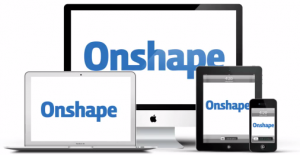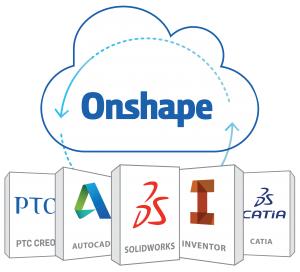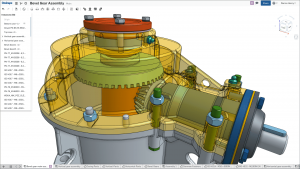 For a design engineer, the ability to use MCAD (mechanical computer aided design) is one of his greatest assets. Using CAD, engineering teams can collaborate to create, edit, view, and share their designs. Traditionally, CAD programs such as SolidWorks, Creo, and Autodesk must be downloaded, configured, and installed in order to operate. Recently, a new CAD concept has emerged which aims to revolutionize the way in which engineers design parts and assemblies. The concept is called Onshape.
For a design engineer, the ability to use MCAD (mechanical computer aided design) is one of his greatest assets. Using CAD, engineering teams can collaborate to create, edit, view, and share their designs. Traditionally, CAD programs such as SolidWorks, Creo, and Autodesk must be downloaded, configured, and installed in order to operate. Recently, a new CAD concept has emerged which aims to revolutionize the way in which engineers design parts and assemblies. The concept is called Onshape.
It’s a cloud-based CAD program where there is no software to download and install. Access is as simple as typing in a URL and logging in to an account. It is the first, and only, full-cloud 3D CAD system that lets a design team simultaneously work together using a web browser, phone, or tablet. Being a proponent of developing technologies, Tipton Design and Engineering had an opportunity to demo Onshape.
Developed by the same team that created SolidWorks, Onshape delivers a familiar experience for the seasoned CAD designer. A simple user interface populated with the essential design commands are easily located. Using the commands to create and edit parts is a breeze. Additionally, Onshape is very user-friendly for the engineer looking to break into CAD  design. The provided tutorials make learning the basics of sketching and modeling simple and almost intuitive. For those looking for a strong parametric modeling tool without going all out on professional software, this is it. As an added bonus, Onshape is equipped to handle native files from other CAD programs, as well as STEP and IGES files. One can even export files created in Onshape to be opened in one of the aforementioned CAD programs.
design. The provided tutorials make learning the basics of sketching and modeling simple and almost intuitive. For those looking for a strong parametric modeling tool without going all out on professional software, this is it. As an added bonus, Onshape is equipped to handle native files from other CAD programs, as well as STEP and IGES files. One can even export files created in Onshape to be opened in one of the aforementioned CAD programs.
What is interesting about Onshape’s model is that it is a subscription based service, developed for use by everyone from the casual engineer to an entire company’s engineering team. Prices start at $0 – yes, that’s right, free! – for students and moonlighters, and rise to $100 per user per month for the professional CAD designer. Both packages offer access to the same features; however, the difference is the number of active documents that can be stored on Onshape’s servers at a time.
When you first get access to Onshape, your initial view of the product is the Documents page. Here you can access and view your Private and Public documents. The tutorial and sample files and can be accessed from the navigation pane on the left side of the page. Each document displayed in the center of the page is listed in a Detail view, with a settings button at the end of each row. Essentially it represents a single design set. Within the document you can create parts, assemblies, and eventually drawings. These appear at the bottom of the screen in tabs. Onshape refers to these different environments as ‘Studios’.
Building a part in Onshape is surprisingly simple. Sketching is similar to Autodesk Inventor. All you have to do is type in a dimension or expression to set the  parameter. The biggest drawback to sketching with Onshape is that you are not able to create parametric relations in a sketch. Additionally, selecting and deselecting sketch entities can be a cumbersome process at times.
parameter. The biggest drawback to sketching with Onshape is that you are not able to create parametric relations in a sketch. Additionally, selecting and deselecting sketch entities can be a cumbersome process at times.
When it comes to actual part modelling, the process is simple enough. Unfortunately, several extra steps were needed to create the same effect that may have only taken 1-2 steps in SolidWorks. For the time being, part modelling in Onshape most closely resembles part modelling in ProE / Creo. One nice feature that Onshape delivers well is its fillet and chamfer selector. It can be manipulated by selecting faces, edges, or both. This gives the user a little more control over their designs.
The assembly aspect of Onshape is an area in which I would have liked to spend a little more time in to better understand its potential. I found the process of creating mates and building an assembly to be relatively simple. Unfortunately, when zooming the view or rotating the viewing area, Onshape’s user interface was sometimes clunky and rather unresponsive. I could imagine some frustration when working with larger assemblies that use a lot of small parts.
The last feature of Onshape to explore was setting up drawings for the parts and assemblies once they have been created. Surprisingly, this process was simpler than expected. Snapping dimensions between edges in a drawing view is fluid. The drawing documents features serve their purpose well.
Onshape is still in its infancy. Nonetheless, I would argue that it is already a contender in the world of CAD programs. The web-based service translates well for continuous upgrading and patching of Onshape’s services and features. Certainly, This will be highly beneficial as Onshape’s user base grows and those users provide feedback with their experience. For the time being, Onshape may best serve as a tool to be used alongside existing tools. However, in the next 5-10 years Onshape could be a leading example for the future of engineering design work. The aspect of design collaboration, in my opinion, will be the key to success of Onshape. The future looks promising as Onshape has already laid the groundwork to attract a diverse and knowledgeable community.
For more information about Onshape, please visit the website here.
